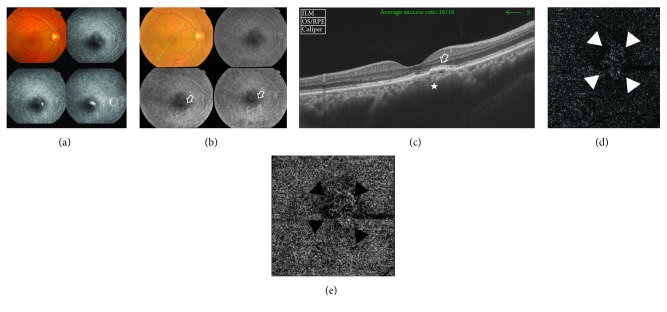Figure 1.
(a) The colored photo and FFA of the right eye of a 52-year-old male during acute CSCR. The macular area shows neurosensory detachment, measuring approximately 3 DD. Corresponding FFA shows a typical smoke-stack leaking pattern. (b) The colored photo and FFA of the same eye 2 years later. The posterior pole shows minimal retinal pigment disturbance in the inferior portion of the macular area along with subretinal deposits. On FFA, the old site of acute leakage demonstrates early pinpoint hyperfluorescence with increasing intensity through late frames suggestive of chronic point of leakage (open arrow). The area of pigment epitheliopathy seen in the colored photo shows hyperfluorescence due to window defect. (c) The corresponding SS-OCT image in a radial scan mode shows shallow PED with surface undulations and hyperreflective sub-RPE deposits (open arrow). There is associated disruption of ELM and IS/OS layers in the vicinity of the PED. Note the generalized dilatation of the choroidal vessels that is most marked in the area beneath the PED (star). Subfoveal choroidal thickness is 737 μ. (d) The en face SS-OCTA image of the same eye taken at the level of the outer retina in a 6 mm × 6 mm field. Note the hyperintense signal caused by increased blood flow within the vascular network of tiny interlacing capillaries (white arrow heads). The neovascular complex is surrounded by a hypointense hollow zone intervening between the lesion and the surrounding normal outer retina that generates a hypointense signal due to the absence of blood flow and is displayed as a dark-grey background. (e) The en face SS-OCTA image of the same lesion at the level of the choriocapillaris (black arrow heads).

